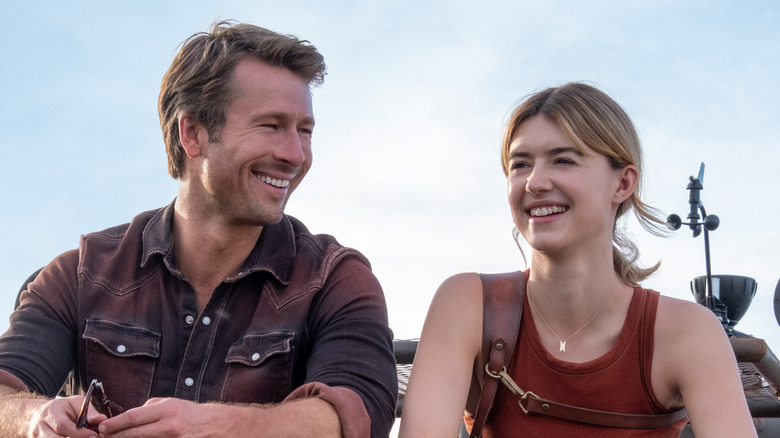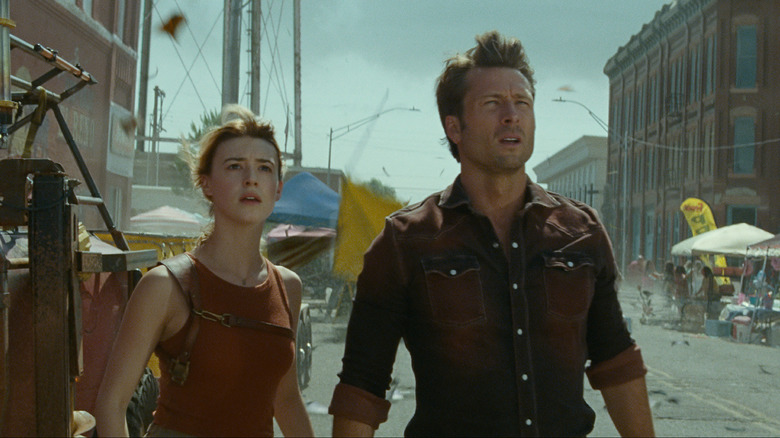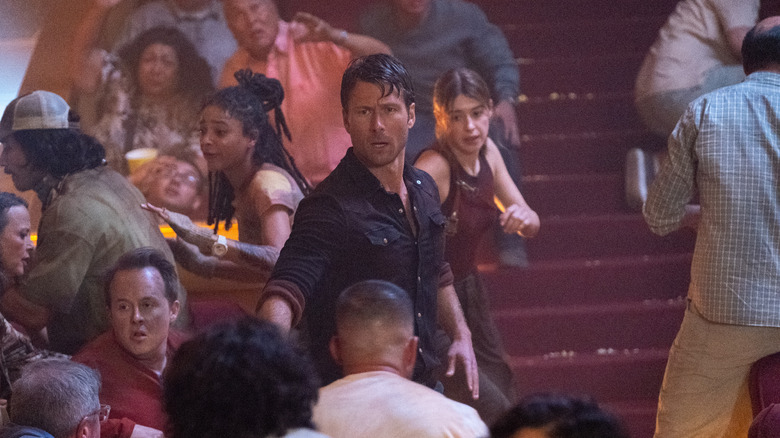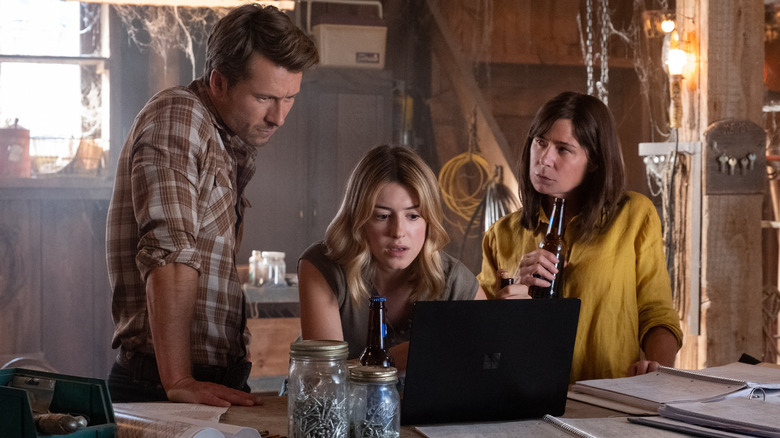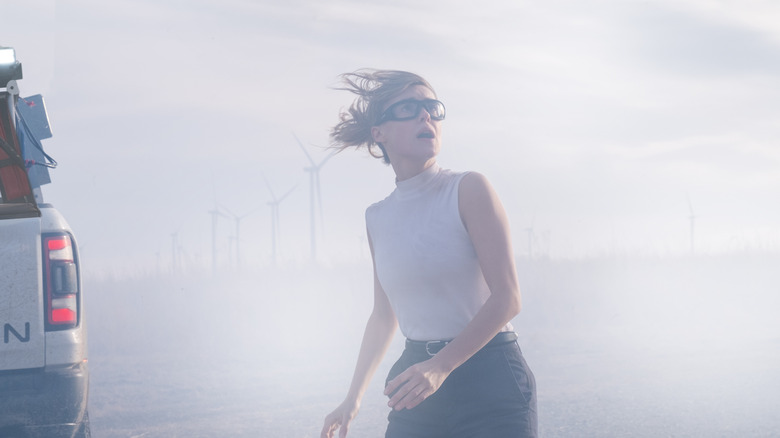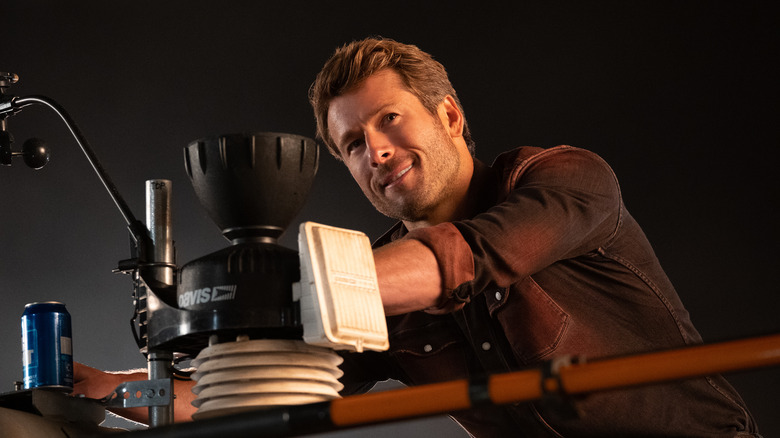Twisters' Glen Powell & Daisy Edgar-Jones Reveal The Science Of Selling Tornadoes - Exclusive Interview
In 1996, Steven Spielberg's Amblin Entertainment, "Jurassic Park" writer Michael Crichton, and "Speed" director Jan de Bont took the disaster movie to a whole new level with "Twister," in which Helen Hunt and the late, great Bill Paxton played professional storm chasers trying to deploy a new early warning system in the midst of a severe tornado outbreak in Oklahoma (where the movie was actually filmed). Earning nearly $500 million worldwide, as well as Oscar nominations for sound and visual effects, "Twister" put the fury of extreme weather on screen in a way that had never been seen before.
Now it's 2024, and "Minari" director Lee Isaac Chung has brought the long-developing update "Twisters" to the screen. Returning to the Sooner State — where even more dangerous tornadoes are occurring with greater frequency — "Twisters" stars Daisy Edgar-Jones as Kate Carter, a young scientist riddled with guilt over the loss of several friends in a storm-chasing incident. Lured back to the field by her colleague Javi (Anthony Ramos), Kate meets the swaggering, cocky chaser Tyler Owens (Glen Powell), who gradually persuades her to reactivate her own experiments in weakening the tornadoes' power.
"Twisters" is a first step into blockbuster filmmaking for Edgar-Jones, following her acclaimed turns in films like "Fresh" and "Where the Crawdads Sing." Powell, meanwhile, has been on a tear lately: Following his breakout role as Hangman in 2022's "Top Gun: Maverick," he recently scored as the lead and co-writer of the genre-bending Netflix crime comedy "Hit Man." As someone who experienced tornadoes himself as a child, the Texas native tells Looper in our exclusive interview that "Twisters" is personal for him: "As a kid, to see the power of these things and what it can take, but also how a community rallies around to salvage things, was incredible."
Watching the original movie
Glen, you were 8 when the first movie came out.
Glen Powell: That sounds about right.
Daisy, you weren't here when the first movie came out.
Daisy Edgar-Jones: Yeah, I wasn't born.
Do you remember both seeing it and how you reacted to it?
Edgar-Jones: I had heard of "Twister," but like you said, I wasn't born before when it came out, so actually, I watched it knowing that [director Lee Isaac Chung] was going to make our version of it, and I loved him as a filmmaker. I was such a huge fan of "Minari" and his work, so him taking on this big blockbuster, I was like, "Wow, I'm really interested in what has intrigued him about it." I went and watched it and fell in love with the world of storm chasing and the characters, and it's so joyful and fun and thrilling to watch. That was how I was introduced to it.
Powell: As a kid, I watched it. I found out that it was the first DVD [released in the U.S.], which makes a lot of sense because everybody has that DVD. It's one of those seminal experiences, and the more I travel the world, the more I realize it's such a groundbreaking movie, and it's a movie that means so much to people. It's not a title that everyone talks about all the time when you talk about movies over the course of time, but now the reaction I get when I tell people about "Twisters," they're like, "No way." They get so excited, and there's a texture to that world and there's a nostalgia there. There was something so groundbreaking at the time, and I think it's a world that a lot of people want to return to. And I think we've nailed it in terms of what makes that world so fun and what makes it worthy of being returned to.
Committing to the story
Daisy, this is your first lead role in a large-scale movie like this. What's it like being on the set for something like this after doing a lot of smaller projects?
Edgar-Jones: Gosh, it was so phenomenal stepping on some of these sets, working with the absolute best of the best in terms of every department. We had an incredible camera crew, incredible stunt crew, incredible set builders and production designer, and a phenomenal cast and director. You felt how huge it was, especially because so much of what we did was done for real. We weren't really working with green screen; we were [working] with special effects. They were dropping actual horse trailers on us, and people were getting thrown up on wires, and I was like, wow, this feels like a real "pinch me" moment every time I stepped on set, truly. I feel so grateful that Isaac as our director was such a great leader because I felt new in that space, and he guided us and held us.
Powell: Daisy made it look really, really easy. Her approach to acting in general is so full commitment that the transition from what she's done to this — she made it look so effortless. A movie of this size and this scale, especially that requires so many different skill sets and not only selling the scientific stuff and genuinely being intelligent — Daisy is very, very smart, but [you have to sell] that science in a way that you actually authentically believe the science. So often we see action movies or things like that where they're doing pseudoscience, and they're trying to sell it, and you're like, "That person has no idea what they're talking about." Daisy really, really put in the work to know.
In addition to that, on the action side, it was full commitment. She put her body on the line. I thought I was going to be the gym rat on this movie. It was not the case. Daisy was in there every time. We had a lot of great gym time together. And it requires that. Audiences don't show up for a movie like this unless they see that the lead of the movie, and it feels authentic and it feels honest. Daisy breathed authenticity into every frame of it.
Talking tornadoes
You had an advisor who instructed the cast on tornado science. How much does it help the performance to absorb and understand the science and feel confident when you're saying that stuff?
Powell: I couldn't do it unless I understand what I'm saying. That's basic acting 101. But what makes this specifically difficult is there are very few words that you would normally use in real conversations. I remember Daisy and I getting out of the car — this was early on in the shoot. There's this scene where we hop out of the truck, and we're chasing for the first time together and looking at the same storm with this mutual excitement. It's a really great sequence. It's one of my favorite sequences in the movie, but there's this one thing where we jump out of the truck and some of the dialogue that was there wasn't really working.
So Daisy said, "Okay, why don't you just talk about the striations?" And I'm like, "What's a striation?" It was a lot of that on set. The fact is that we had access to the best of the best in terms of the National Weather Center and NOAA [National Oceanic and Atmospheric Administration] and all real storm chasers. There's no way we could have pulled this movie off anywhere else except Oklahoma.
You don't talk about silver iodide and polymers every day in normal conversation?
Powell: I do. I do. Just in the privacy of my own home. It's sort of my thing, yeah.
A dance of death
Daisy, you mentioned that so much of the action was done practically. If I asked both of you what the most difficult practical day on set was, would you have the same answer, or would you have two different answers?
Edgar-Jones: I wonder. God, there were so many difficult practical days. It's hard to choose. Each tornado had its own difficulties or challenges, but one that sticks out for me that I'm really proud of is there's a scene that we do in a motel, which is a tornado sequence that's done all on a oner [a single, extended take that appears to be uninterrupted]. It was a lot of really technical camera moves, but we also had a huge amount of different practical effects coming in that day. We had a horse trailer drop; we had people on wires. Isaac really wanted to show how quickly and how powerful and how damaging a tornado can pass through somewhere and the effect of that.
We start above this pool, and it comes down, and when we come back up, the whole place is flattened. I remember getting that right was so important and all the different technical bits and every little section having to work. We shot on film, so so much of it was about nailing it really quickly. We were also filming at that point in December in tank tops and shorts with rain and wind machines, so we were also freezing, and trying to act in general was difficult. That was challenging.
Powell: One of the reasons that I am really proud of that sequence as well was we were considering how the audience was experiencing every single moment. When you shoot something in a oner, the entire purpose is to almost be gauging the audience's breath. With no cuts, you don't allow the audience to have a break. You don't even almost allow them to blink sometimes. That's the whole purpose of it — to keep tension in there. The interesting part about it is that it's really a dance move. It's a giant dance choreography where you're understanding where and when these big things are falling from the sky or people are getting dragged and how the camera is moving and how the audience is digesting and receiving those moments.
What's so incredible about that sequence is there's almost internal music to it. It's a really beautiful dance, but with visceral, aggressive, and violent action that emulates what Isaac based it on, which was experiencing a tornado in real time. It's a hard thing to pull off. It's harder than you think. Oners are done all the time, but oners with this many practical elements are very rare.
For Glen Powell, Twisters is personal
Glen, you had two personal connections to this movie. One, your family experienced a tornado when you were 9, and the other one was you got to talk with Bill Paxton about the original while working with him [on 2013's "Red Wing"]. How did both of those experiences inform your work in this movie?
Powell: I was just talking to my mom about that F5 tornado I experienced when I was 9 years old with my aunt and car full of cousins. That was one of the first conversations that Daisy and I had when we started the movie. I think it was our first day meeting each other, and I was talking about the feeling of my aunt driving this car. It was the first time I saw my aunt so scared and out of control. As a kid, when you see an adult in that state, it kind of alters the chemistry of your brain and makes you go, "What are they afraid of? What is this thing that's so unwieldy and scary that we all should be in this car?" [For] all my cousins, everybody, it was a very scary moment.
My mom reminded me, though, that there were other experiences with tornadoes as kids. One actually put a tree on top of our house, and I forgot about that moment as a kid. It blocked off our street. She also talked about that F5 tornado in general. When we were picking up after that tornado, one of the things was that everybody wanted ... Sure, you can try to find pets or things like that, but really in those moments, we were trying to find people's pictures. We were looking for family photos. As soon as you found a family photo, you'd stash it and bring it to a collective place where everybody could sort through them. Those are the things you can't replace.
As a kid, to see the power of these things and what it can take, but also how a community rallies around to salvage things, was incredible. Bill was such a great guardian of that idea. He was such a generous person. In terms of the original "Twister," his experience on that movie never left him. The way he looked up at the sky was enviable, and I feel like after this movie, we have that same sort of twinkle.
"Twisters" opens in theaters this Friday, July 19.
